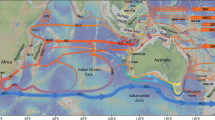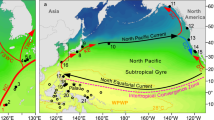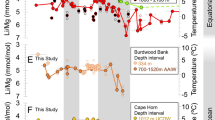Abstract
During the last glacial period and deglaciation, climate shifts in the Northern and Southern Hemispheres occurred asynchronously, cooling in one coinciding with warming in the other1,2,3,4,5,6. This asymmetry has been attributed to the phenomenon known as the bipolar seesaw1, which, in turn, has been linked to latitudinal shifts of the southern westerly wind belt2. The southern westerlies substantially determine the location of the oceanic Subtropical Front. A more poleward location of the Subtropical Front allows the Leeuwin Current, which carries warm tropical water along the west coast of Australia to extend at times as far as Tasmania. Here we use multiple proxies obtained from a sediment core off the southern coast of Australia to reconstruct sea-surface temperature and other environmental conditions, both marine and terrestrial, from 33,000 to 10,000 years ago. We find millennial-scale warm phases south of Australia and attribute them to the presence of the Leeuwin Current. The warm phases are synchronous with cool Northern Hemisphere Heinrich Stadials7 and coincide with warm intervals south of Africa and in the western tropical Atlantic Ocean6. We therefore suggest that the poleward displacement of the Subtropical Front during these intervals extended across the Indian Ocean, thus promoting the leakage of warm Indian Ocean water via the Agulhas Current6 into the Atlantic Ocean.
This is a preview of subscription content, access via your institution
Access options
Subscribe to this journal
Receive 12 print issues and online access
$259.00 per year
only $21.58 per issue
Buy this article
- Purchase on Springer Link
- Instant access to full article PDF
Prices may be subject to local taxes which are calculated during checkout




Similar content being viewed by others
References
Blunier, T. & Brook, E. J. Timing of millennial-scale climate change in Antarctica and Greenland during the last glacial period. Science 291, 109–112 (2001).
Denton, G. H. et al. The last glacial termination. Science 328, 1652–1656 (2010).
Blunier, T. et al. Asynchrony of Antarctic and Greenland climate change during the last glacial period. Nature 394, 739–743 (1998).
Wang, X. et al. Interhemispheric anti-phasing of rainfall during the last glacial period. Quat. Sci. Rev 25, 3391–3403 (2006).
Broecker, W. S. Paleocean circulation during the last deglaciation: A bipolar seesaw? Paleoceanography 13, 116–121 (1998).
Barker, S. et al. Interhemispheric Atlantic seesaw response during the last deglaciation. Nature 457, 1097–1103 (2009).
Zarriess, M. et al. Bipolar seesaw in the northeastern tropical Atlantic during Heinrich stadials. Geophys. Res. Lett. 38, L04706 (2011).
Beal, L. M., De Ruijter, W. P. M., Biastock, A., Zahn, R. & SCOR/WCRP/IAPSO working group 136, On the role of the Agulhas system in oceanic circulation and climate. Nature 472, 429–436 (2011).
Hemming, S. R. Heinrich events: Massive Late Pleistocene detritus layers of the North Atlantic and their global impact. Rev. Geophys. 42, RG1005 (2004).
Zahn, R. Beyond the CO2 connection. Nature 460, 335–336 (2009).
Biastoch, A., Böning, C. W., Schwarzkopf, F. U. & Lutjeharms, J. R. E. Increase in Agulhas leakage due to poleward shift of Southern Hemisphere westerlies. Nature 462, 495–499 (2009).
Bard, E. & Rickaby, R. E. M. Migration of the subtropical front as a modulator of glacial climate. Nature 460, 380–384 (2009).
Belkin, I. & Gordon, A. Southern Ocean fronts from the Greenwich meridian to Tasmania. J. Geophys. Res. 101, 3675–3696 (1996).
Peeters, F. J. C. et al. Vigorous exchange between the Indian and Atlantic oceans at the end of the past five glacial periods. Nature 430, 661–665 (2004).
Barrows, T. T. & Juggins, S. Sea-surface temperatures around the Australian margin and Indian Ocean during the Last Glacial Maximum. Quat. Sci. Rev. 24, 1017–1047 (2005).
Sikes, E. L. et al. Southern Ocean seasonal temperature and Subtropical Front movement on the South Tasman Rise in the late Quaternary. Paleoceanography 24, PA2201 (2009).
Levi, C. et al. Low-latitude hydrological cycle and rapid climate changes during the last deglaciation. Geochem. Geophys. Geosyst. 8, Q05N12 (2007).
Calvo, E., Pelejero, C., De Deckker, P. & Logan, G. A. Antarctic deglacial pattern in a 30 kyr record of sea surface temperature offshore South Australia. Geophys. Res. Lett. 34, L13707 (2007).
Rühlemann, C., Mulitza, S., Müller, P. J., Wefer, G. & Zahn, R. Warming of the tropical Atlantic Ocean and slowdown of thermohaline circulation during the last deglaciation. Nature 402, 511–514 (1999).
Lee, S-Y., Chiang, J. C. H., Matsumoto, K. & Tokos, K. S. Southern Ocean wind response to North Atlantic cooling and the rise in atmospheric CO2: Modelling perspective and paleoceanographic implications. Paleoceanography 26, PA1214 (2011).
EPICA community members, Eight glacial cycles from an Antarctic ice core. Nature 429, 623–628 (2004).
EPICA community members, One-to-one coupling of glacial climate variability in Greenland and Antarctica. Nature 444, 195–198 (2006).
Stott, L., Timmermann, A. & Thunell, R. Southern hemisphere and deep-sea warming led deglacial atmospheric CO2 rise and tropical warming. Science 318, 435–438 (2007).
De Deckker, P. & Yokoyama, Y. Micropalaeontological evidence for Late Quaternary sea-level changes in Bonaparte Gulf, Australia. Glob. Planet. Change 66, 85–92 (2009).
De Deckker, P., Tapper, N. J. & van der Kaars, S. The status of the Indo-Pacific Warm Pooland adjacent land at the Last Glacial Maximum. Glob. Planet. Change 35, 25–35 (2003).
Toggweiler, J. R. Shifting westerlies. Science 323, 1434–1435 (2009).
Grootes, P. M., Stuiver, M., White, J. W. C., Johnsen, S. & Jouzel, J. Comparison of oxygen isotope records from the GISP2 and GRIP Greenland ice cores. Nature 366, 552–554 (1993).
Acknowledgements
We are grateful to T. T. Barrows who provided much valuable feedback to several drafts of the manuscripts and also for carrying out the SST reconstructions using his AUSMAT-F4 database, and to S. J. Fallon who performed some of the accelerator mass spectrometry (AMS) 14C analyses. We also thank H. Arz and T. Dokken for fruitful discussions. P.D.D. thanks the Australian National Ocean Office for funding the cruise in March 2003, Yvon Balut and the Institut Polaire Français (IPEV) for logistical support and coring facilities, the Australian Research Council for grant DP0344932, and Australian Institute of Nuclear Science and Engineering (AINSE) grant 05/36 for some of the AMS dating. The Norwegian Research Council supported the Bjerknes Centre and AMS 14C dates and stable isotope analyses. J. Shelley is thanked for sample preparation and picking some of the foraminifera and R. Soraas for expert help and calibration with the mass spectrometer data.
Author information
Authors and Affiliations
Contributions
P.D.D. and M.M. equally contributed to the writing of the manuscript with additional support from the other two authors. P.D.D. collected the core and did some preliminary work on it, and this was followed by significant data contributions by M.M. (isotopes, XRF scanning, XRD analyses) and K.P. (foraminifer faunal counts). E.J. contributed to the ideas and writing of the manuscript, and financially supported part of the project.
Corresponding authors
Ethics declarations
Competing interests
The authors declare no competing financial interests.
Supplementary information
Rights and permissions
About this article
Cite this article
De Deckker, P., Moros, M., Perner, K. et al. Influence of the tropics and southern westerlies on glacial interhemispheric asymmetry. Nature Geosci 5, 266–269 (2012). https://doi.org/10.1038/ngeo1431
Received:
Accepted:
Published:
Issue Date:
DOI: https://doi.org/10.1038/ngeo1431
This article is cited by
-
Last Glacial Maximum cooling induced positive moisture balance and maintained stable human populations in Australia
Communications Earth & Environment (2024)
-
Southern Ocean glacial conditions and their influence on deglacial events
Nature Reviews Earth & Environment (2023)
-
Antarctic evidence for an abrupt northward shift of the Southern Hemisphere westerlies at 32 ka BP
Nature Communications (2023)
-
A contracting Intertropical Convergence Zone during the Early Heinrich Stadial 1
Nature Communications (2023)
-
A deep Tasman outflow of Pacific waters during the last glacial period
Nature Communications (2022)



